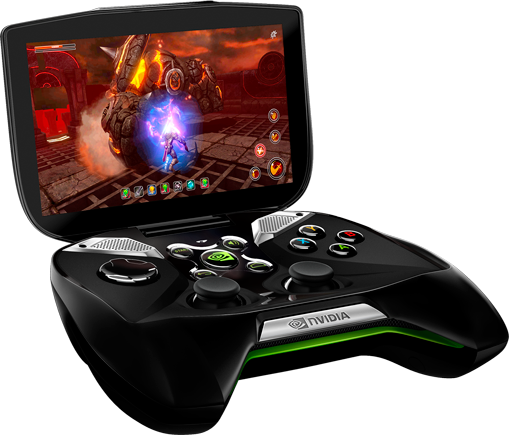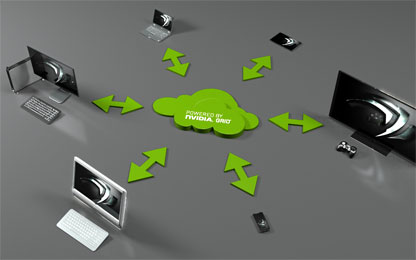Calling it another device for the gamer’s backpack is too simplistic.
By Jon Peddie
[Editor’s Note: This article is excerpted from a more detailed report in the current issue of Jon Peddie Research TechWatch.]
Project Shield, Nvidia’s Android-Tegra game controller with a screen, is striking when first seen. However, the configuration is not novel. Game controllers that hold a mobile phone or a tablet have been available and/or announced for a while.
Nvidia’s Project Shield consists of a console-like game controller, with a dedicated and permanently attached five-inch 720p multi-touch display, powered by Nvidia’s latest ARM-based processor, Tegra 4, running Google’s Jellybean release of Android.

It is an appealing product and irresistible to pick up; is that enough to make it disruptive? Mobile phones certainly existed before Apple introduced the iPhone, yet not many would dispute it was a transformational and disruptive product—but was it?
In Clayton M. Christensen’s 1997 best-selling book, “The Innovator’s Dilemma,” he separates new technology into two categories: sustaining and disruptive. Disruptive technology lacks refinement, often has performance problems because it is new, appeals to a limited audience, and may not yet have a proven practical application.
The description of disruptive hardly fits Nvidia’s Project Shield, or the iPhone. It is doubtful Project Shield will have very many, if any, performance problems as compared to any other new product, including the iPhone. It may have a limited audience, namely game players, but there are about 30 million of them (hardcore gamers for all platforms approaches 300 million), and so it is a matter of scale when making the determination of “limited.” In addition, the iPhone and Project Shield certainly have proven practical applications.
A Grid peripheral?
Announced at its 2012 GPU Technology Conference, Grid is Nvidia’s approach for an on-demand gaming service. Nvidia claims it will provide advantages over traditional console gaming systems. In addition, it is an “any-device gaming” service, and according to Nvidia, it offers high quality, low-latency gaming on a PC, Mac, tablet, smartphone, and TV.
Nvidia has combined its development of running a game on an x86 based PC with a GeForce graphics add-in board (AIB) and streaming the game to a non-x86 device. That technique uses the non-x86 device as a thin-client (TC), allowing the TC to send commands as well as display the streamed results. Except for the latency, which is a function of the network, the user’s experience is as if the powerful AIB was in his or her local device, which could be a smartphone or tablet. Nvidia has schematized the concept in the diagram shown below. What is not shown in the diagram is a picture of the equipment that comprises the (green cloud-like) Grid in the middle.

The middle part presumably will be a generic server with an Nvidia GeForce AIB, and Nvidia’s low-latency encoder and fast frame buffer capture technology. According to Nvidia’s calculations, Grid will be able to deliver the same throughput and latency as a console.
Added to list of devices that can connect to the Grid is the new Project Shield. Furthermore, through its HDMI output, Project Shield can also drive a large-screen TV as its display, making it even more console-like.
But is any of this disruptive?
I think not. Interesting, yes, clever, yes, well executed, time will tell but Nvidia’s track record suggests it will be.
Jen-Hsun Huang, Nvidia’s charismatic president and founder said he built the Project Shield because no one else was going to make a mobile device like it. He told GamesBeat, “We’re not trying to build a console. We’re trying to build an Android digital device, in the same way that Nexus 7 [users] enjoys books and magazines and movies. This is an Android device for enjoying games. It’s part of your collection of Android devices … The reason why I built this device is because only we can build this device.”
If only Nvidia can build the device, and if the device only runs from an Nvidia Grid server, and only on an Nvidia Tegra processor, then Nvidia has built a proprietary closed garden of sorts. If other services such as Amazon, Google, Steam, or Origin take up the Grid, then it will be more catholic. However, until other providers embrace Grid the performance on Project Shield may be less than stellar, or Nvidia will have to become a streaming game service like Microsoft, Sony, and others. That could be a licensing nightmare and suck enormous resources from the company, not something Huang will undertake lightly.
Assuming the content distribution part of the equation can be worked out—and I have no doubt it will be if it hasn’t already been—Nvidia wouldn’t have made these announcements with an empty gun, and the adoption of the Project Shield becomes one of economics.
An adventurer or an aggregator?
Project Shield couldn’t be done by a startup, no matter how well-funded. An existing consumer supplier like HP or Microsoft probably can’t do it. Nvidia has pulled together all the stuff it has done elsewhere in the company and brought those technologies, infrastructure, and talents to make Project Shield. Once the company decided to do it, it didn’t take very long to produce it.
Nvidia’s focus with Project Shield is raising the bar for native Android gaming, and allowing PC gamers to extend their gaming experience to anywhere in their house. Project Shield, Nvidia emphasizes, is “stock Android” [device], with access to all the Google apps and ecosystem.
The company surveyed their customers and found that 82% of them play games on multiple platforms. “GAMERS” are called that because they like to play games. And so they will play games on various devices, in various situations (home, on a bus, in a waiting room, etc.). Just as we use different devices for listening to music or watching a video depending where we are, game playing requires (needs) devices suited to the environment the user finds oneself in.
Our take
Nvidia is without question the finest high-tech marketing company second only to Apple, and that may be just a function of budget.
The total accessible market for a device like Project Shield is about 200,000 units; if you want to be generous, double it. If the company can sell it for $250, then that’s $50 million (or $120 million if 400,000 are sold at $300) added to the top line, which would be a fine amount of sales for a startup, or maybe a small division in some larger companies. However, is it significant enough for Nvidia to warrant much investment in development or marketing? I think Project Shield will fall into the same category as 3D Surround Vision, or SLI, neat stuff, positions the company as a techno leader, exposes them to other opportunities, and will fade into the background by next year’s Consumer Electronics Show.





